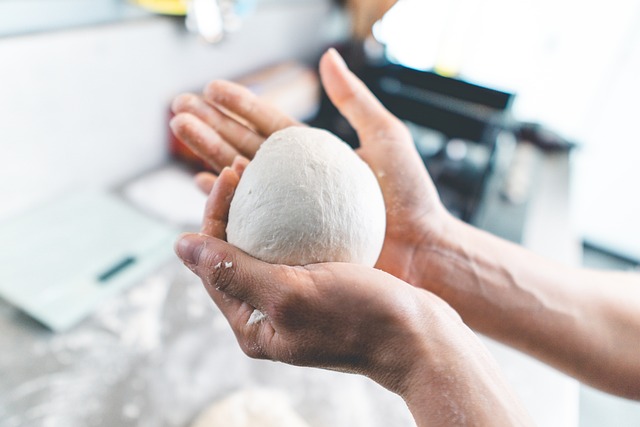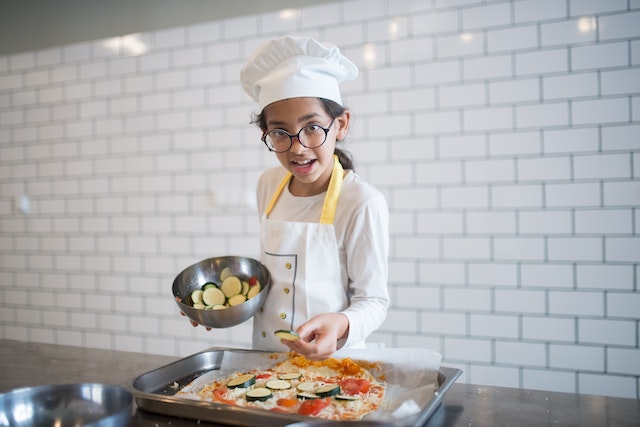Making the perfect pizza is a labor of love–one that requires patience, skill, and practice. From understanding the nuances of recipe preparation to learning how long to knead dough, there are plenty of steps involved in the process if you want it to turn out just right. In this blog post we’ll be taking an in-depth look at one very important part of pizza making – figuring out how long to knead your dough!
How long to knead pizza dough? We’ll cover why kneading is important, tips on finding just the right consistency for your dough, as well as helpful advice for timing so you don’t overwork or underwork it. So whether you’re an experienced pizza maker looking to brush up on your techniques or someone brand new to baking, read on and get ready to make incredible pizzas with ease!
What Is Pizza Dough?
Pizza dough is a versatile base for all kinds of pizzas, from thin-crust to deep-dish. In its simplest form, it consists of four ingredients: flour, water, salt and yeast. Depending on the desired texture, oil may also be added to the recipe. The dough can be either kneaded by hand or machine before being left to rest and rise. After that, it’s ready to be rolled out and topped with your favorite ingredients! With just some basic techniques and a little practice, you can make homemade pizza dough that tastes as good as any restaurant!
When making pizza dough at home, it’s important to use quality ingredients like unbleached all-purpose flour or bread flour. The type of water you use can also affect the texture and flavor, so try using filtered tap water or bottled spring water if you can. The salt should be added sparingly – just enough to bring out all the flavors in your dough. Finally, for best results, allow your pizza dough to rest for at least an hour before rolling it out. This will help create a perfectly light and airy crust with just the right amount of crunch!
Making homemade pizza dough is an enjoyable activity that everyone can enjoy. With a few simple ingredients and techniques, you’ll have delicious pizzas ready in no time! Start experimenting today and see what kind of delicious creations you come up with!
Why Is Kneading Important?
Kneading dough is an important part of making pizza. It carefully blends the ingredients together evenly, so that each bite of pizza delivers a consistent texture and flavor. Kneading also strengthens the gluten in the dough, which gives it elasticity and helps it rise when baked. The process of kneading makes sure all the layers are intertwined securely so that gas bubbles in the dough can’t escape easily–which creates a fluffy, light crust for pizza. In addition to providing structure, kneading also aerates the dough, resulting in an airy texture. With just a few minutes of kneading, you can create an amazing homemade pizza with perfect results every time!
By following these simple steps to knead your dough correctly, you create a pizza that tastes like came from a pizzeria. Kneading is an essential of the pizza-making process shouldn’t be overlooked in order get the best possible results With just a few simple, you can make amazing homemadeas with perfect texture and flavor time. So don’t forget to knead your dough correctly for an amazing result!

How Long To Knead Pizza Dough?
The answer to how long to knead pizza dough depends on the tools you use. If you plan on using your hands, then it is best to knead for about 10 minutes, making sure that all ingredients are evenly distributed throughout the dough. If using an electric mixer with a dough hook attachment, this time can be reduced to five minutes. It is also important to note that after kneading the pizza dough should be allowed to rest before shaping and baking.
This will ensure that the gluten relaxes and gives you a beautiful, even texture when cooked. With either method, once properly kneaded, the dough should form a smooth ball shape and feel elastic and pliable when pressed or stretched thin.
What Are The Ingredients In Pizza Dough?
Pizza dough is a key part of any classic pizza. Making homemade pizza dough is simple and only requires a few ingredients. The following list includes the common ingredients used in making your own pizza dough:
– Flour: All-purpose flour is usually the best choice for most types of pizza dough, but bread flour or even whole wheat flour can also be used.
– Yeast: This helps the dough to rise and provides a light texture. Active dry yeast or instant rapid rise yeast can both be used.
– Sugar: A small amount of sugar helps activate the yeast and sweeten the flavor of the crust slightly.
– Salt: This gives flavor to the crust and prevents it from becoming too dense.
– Oil: This helps keep the dough soft and moist while it is rising. Olive oil, canola oil, or even melted butter can be used.
– The water binds all of ingredients together to form the dough It should be warm but not too so that it does not kill yeast.
Once have gathered your ingredients, making homemade pizza dough is easy and fun! You will likely impress your friends and family with a delicious homemade pizza pie
How Do You Make Pizza Dough?
Making pizza dough requires a few simple ingredients and is easy to do. Here is a list of the basics you’ll need:
– Flour, ideally all-purpose
– Salt
– Water
– Yeast (active dry or instant)
– Extra virgin olive oil
Once you have these items, making your pizza dough is relatively straightforward. Begin by combining 1/4 teaspoon of salt with 2 1/4 cups of flour in a large bowl. In a separate container, mix together 1 cup of water at room temperature with 2 teaspoons of yeast and 1 tablespoon of extra virgin olive oil. Add this mixture to the flour and salt in the bowl and stir until it forms a sticky ball. If needed, you can add a bit more water or flour to achieve the desired consistency.
Once it’s blended, knead your dough on a lightly floured surface for about 10 minutes until it is smooth and elastic. Finally, place in an oiled bowl and cover with plastic wrap or damp cloth and let rise for about 1 hour before using.
This recipe yields enough pizza dough for two large pizzas. Feel free to double or triple the ingredients if you’re making more than one pie. Now that you know how to make basic pizza dough, get creative with your toppings and enjoy your homemade pizza creation!

Tips For Kneading Pizza Dough
Once the dough has been given enough time to rise, it’s time to knead. Kneading is an important part of making pizza dough and can help create a crust that bakes evenly and is tasty. Here are some tips for kneading pizza dough:
– Start with a lightly floured surface and flour your hands as well. This will prevent the dough from sticking as you work with it.
– Use the heel of your hand to press down firmly on the dough and push away from you in one motion. Fold the far edge over towards you, then repeat the pressing down motion again with the heel of your hand.
– Rotate the dough about 45 degrees after each kneading session. This will help you create a smooth and elastic dough that’s easy to shape and roll out.
– Keep kneading the dough until it is soft and pliable, approximately 10 minutes. You’ll know when it’s ready if an indent remains after pressing your thumb into the surface of the dough.
– Allow the pizza dough to rest for about 15 minutes before rolling it out and adding toppings. This step helps ensure an even bake when cooking in an oven or on a griddle/grill.
Following these steps can help make sure you achieve a perfect pizza every time!
What Is The Best Way To Knead Pizza Dough?
Kneading pizza dough is an essential step in creating the perfect homemade pizza. The right technique can make a huge difference to the texture and flavor of your final product. Here are five simple steps that you should follow when kneading pizza dough:
– Flour Your Work Surface – Before you start, sprinkle some flour on your work surface so the dough doesn’t stick. Make sure you spread it out evenly and use enough to keep the dough from sticking.
– Turn Out The Dough – After shaping your dough into a ball, place it on the floured surface and push down lightly with your hands to flatten it slightly before starting to knead.
– Push Away From You And Fold – With your hands flat on the dough, push away from you with one hand while pulling back and folding the dough with the other.
– Turn The Dough And Repeat – Once you’ve pushed away from you and folded the dough, turn it 90 degrees and repeat. Continue doing this until your dough is smooth and elastic.
– Let It Rest – After kneading, place your pizza dough in an oiled bowl, cover tightly with plastic wrap or a damp towel and let it rest for about 30 minutes before using it to make pizzas. This will help to relax the gluten in the flour so that you can stretch it easily without it becoming too tough.
Following these simple steps is all it takes to make the perfect pizza dough. By taking care with your kneading technique, you can ensure that your homemade pizzas will be crisp, light and delicious!
>>> You might also like:
How Long to Cook Digiorno Pizza?
How Long Does Pizza Take to Cook?
How Do I Know If My Pizza Dough Is Sufficiently Kneaded?
Once the dough has been mixed and the ingredients are evenly distributed, it is time to knead the dough. Kneading is an important step in making pizza dough as it helps develop gluten networks within the dough that will provide structure and make it easier to shape. To ensure your pizza dough has been adequately kneaded, use these tests:
– The Windowpane Test: Take a small piece of dough and stretch it between your thumbs until thin enough to see through. If you can create a windowpane-like effect without any tears or holes in the stretched dough, then your pizza dough is properly kneaded.
– The Finger Test: Push two fingers into a piece of raw pizza dough and if they come out clean without any dough sticking to them, then the dough has been properly kneaded.
– The Bounce Test: If you drop a small piece of dough from about one foot above a flat surface and the dough bounces back up after hitting the ground, it is adequately kneaded.
By taking these tests into consideration when preparing your pizza dough, you can ensure that your pizzas will have the perfect texture!

What Are The Consequences Of Not Kneading Pizza Dough Enough?
When making pizza dough, it is important to knead the dough properly. If the dough is not kneaded enough, it can have a number of consequences. Kneading helps to develop gluten in the dough which gives it an elastic texture and allows it to rise when baked. Without proper kneading, the crust will lack structure and may be dense and heavy instead of light and fluffy.
Additionally, if not kneaded enough, the crust may not hold its shape during baking and could end up being too thin or too thick. Finally, insufficient kneading often results in a less flavorful pizza crust as the ingredients are not fully incorporated into the dough. To ensure optimal results when making pizza at home, make sure that you knead the dough properly to avoid these consequences.
Common Mistakes People Make When Making Pizza Dough
Pizza is one of the most beloved dishes in the world, but it can be tricky to get just right. When making pizza dough at home, there are a few common mistakes that people make.
One mistake is using too much flour when creating the dough. Too much flour will result in a stiff and dry crust that doesn’t have enough elasticity or rise during baking. It’s important to measure out the correct amount of flour according to your recipe and use it sparingly so as not to overwork the dough.
Another mistake is overkneading or working the dough too hard by hand or with a mixer attachment. This can result in a tough, chewy crust instead of one that is light and airy. It’s important to knead the dough until it has an elastic texture, but not so much that it becomes dense.
Finally, using the wrong type of yeast is a common mistake when making pizza dough. Active dry yeast is usually the best choice for homemade pizzas as it will provide consistent results and rise quickly. Using too much or too little yeast compared to the recipe instructions can have a big impact on how well the dough rises during baking.
By avoiding these common mistakes, home cooks can create delicious pizzas with perfect crusts every time!
What Are Some Recipes That Use Pizza Dough?
Pizza dough is a versatile ingredient that can be used for a variety of recipes. From savory pies to sweet treats, there are many delicious recipes that use pizza dough as their main base. Here are some popular recipes made with pizza dough:
– Calzones – A classic Italian dish that consists of a folded-over pizza filled with cheese and other ingredients such as meats or vegetables.
– Pizza Pockets – Similar to calzones, but they have an open top so you can see the tasty ingredients inside!
– Stromboli – An Italian-American dish consisting of rolled pizza dough stuffed with meats and cheeses, then baked in the oven.
– Monkey Bread – A sweet, pull-apart bread made from pieces of pizza dough coated in melted butter and, then baked until golden brown.
. Garlic Knots – Tasty knots of pizza dough that are lightly brushed with garlic butter and sprinkled with herbs for additional flavor.
– Soft Pretzels – A salty treat made by forming pieces of pizza dough into a pretzel shape and baking them until fluffy and golden brown on the outside.
– Cinnamon Rolls – Sweet rolls made with rolled out pieces of pizza dough that are filled with cinnamon-sugar, rolled up, cut into slices, and baked to perfection!
These recipes all make great use of pizza dough and can easily be customized to your own tastes. So the next time you’re looking for a delicious treat, why not give one of these recipes a try? With pizza dough, the possibilities are endless!
>>> See more: “The Bertinet Method: Slap & fold kneading technique” with Richard Bertinet
Conclusion: Kneading pizza dough is a therapeutic process that can be done in as little as 8 minutes and up to 10 minutes. With the right technique, consistent kneading and proper ingredients, you can make delicious crust for your favorite pizzas. A great pizza starts with a perfect dough that is well-kneaded and well-seasoned. With the tips from this article, you should be able to make dough that your family and friends will rave about!
So if you’re looking to make a yummy pizza crust at home, get started by determining how long to knead pizza dough based on the three methods above. Once you’ve got that figured out, it’s time to preheat your oven and grab those toppings – let’s get baking!
The Village Pizza Nags Head blog is full of the latest news, deals, and information about our delicious pizza!

